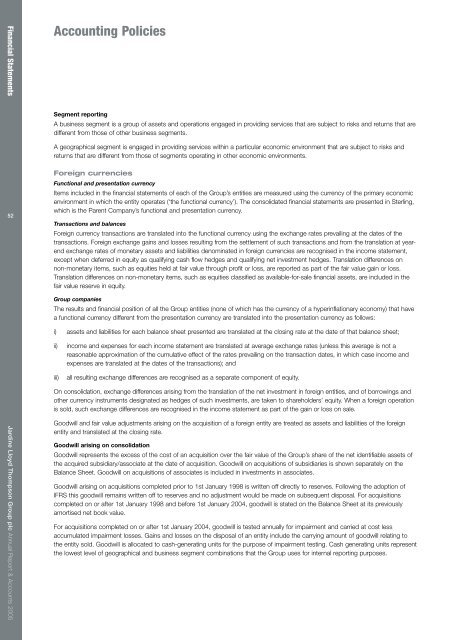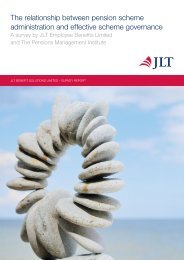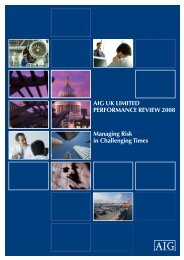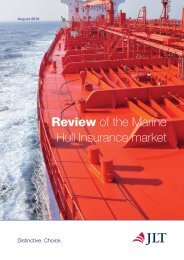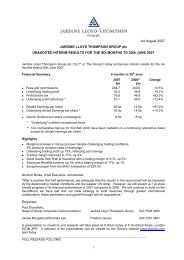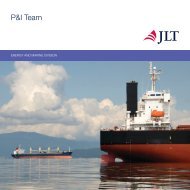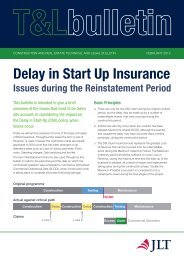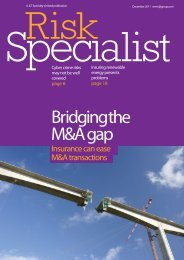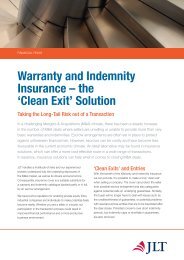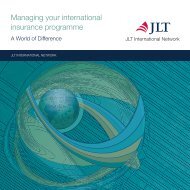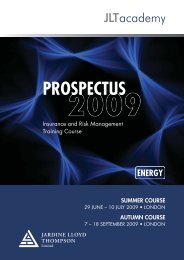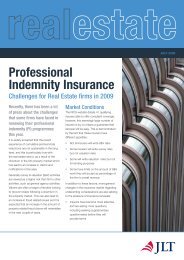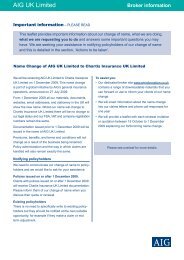Report & Accounts - JLT
Report & Accounts - JLT
Report & Accounts - JLT
- No tags were found...
You also want an ePaper? Increase the reach of your titles
YUMPU automatically turns print PDFs into web optimized ePapers that Google loves.
Financial StatementsAccounting PoliciesSegment reportingA business segment is a group of assets and operations engaged in providing services that are subject to risks and returns that aredifferent from those of other business segments.A geographical segment is engaged in providing services within a particular economic environment that are subject to risks andreturns that are different from those of segments operating in other economic environments.52Foreign currenciesFunctional and presentation currencyItems included in the financial statements of each of the Group’s entities are measured using the currency of the primary economicenvironment in which the entity operates (‘the functional currency’). The consolidated financial statements are presented in Sterling,which is the Parent Company’s functional and presentation currency.Transactions and balancesForeign currency transactions are translated into the functional currency using the exchange rates prevailing at the dates of thetransactions. Foreign exchange gains and losses resulting from the settlement of such transactions and from the translation at yearendexchange rates of monetary assets and liabilities denominated in foreign currencies are recognised in the income statement,except when deferred in equity as qualifying cash flow hedges and qualifying net investment hedges. Translation differences onnon-monetary items, such as equities held at fair value through profit or loss, are reported as part of the fair value gain or loss.Translation differences on non-monetary items, such as equities classified as available-for-sale financial assets, are included in thefair value reserve in equity.Group companiesThe results and financial position of all the Group entities (none of which has the currency of a hyperinflationary economy) that havea functional currency different from the presentation currency are translated into the presentation currency as follows:i) assets and liabilities for each balance sheet presented are translated at the closing rate at the date of that balance sheet;ii)iii)income and expenses for each income statement are translated at average exchange rates (unless this average is not areasonable approximation of the cumulative effect of the rates prevailing on the transaction dates, in which case income andexpenses are translated at the dates of the transactions); andall resulting exchange differences are recognised as a separate component of equity.On consolidation, exchange differences arising from the translation of the net investment in foreign entities, and of borrowings andother currency instruments designated as hedges of such investments, are taken to shareholders’ equity. When a foreign operationis sold, such exchange differences are recognised in the income statement as part of the gain or loss on sale.Jardine Lloyd Thompson Group plc Annual <strong>Report</strong> & <strong>Accounts</strong> 2005Goodwill and fair value adjustments arising on the acquisition of a foreign entity are treated as assets and liabilities of the foreignentity and translated at the closing rate.Goodwill arising on consolidationGoodwill represents the excess of the cost of an acquisition over the fair value of the Group’s share of the net identifiable assets ofthe acquired subsidiary/associate at the date of acquisition. Goodwill on acquisitions of subsidiaries is shown separately on theBalance Sheet. Goodwill on acquisitions of associates is included in investments in associates.Goodwill arising on acquisitions completed prior to 1st January 1998 is written off directly to reserves. Following the adoption ofIFRS this goodwill remains written off to reserves and no adjustment would be made on subsequent disposal. For acquisitionscompleted on or after 1st January 1998 and before 1st January 2004, goodwill is stated on the Balance Sheet at its previouslyamortised net book value.For acquisitions completed on or after 1st January 2004, goodwill is tested annually for impairment and carried at cost lessaccumulated impairment losses. Gains and losses on the disposal of an entity include the carrying amount of goodwill relating tothe entity sold. Goodwill is allocated to cash-generating units for the purpose of impairment testing. Cash generating units representthe lowest level of geographical and business segment combinations that the Group uses for internal reporting purposes.


